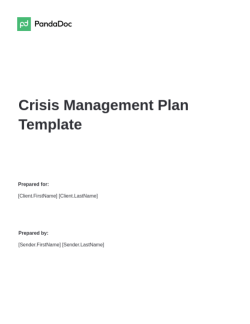In business, everything that could go wrong would most likely go wrong.
And when this happens, you need a crisis communication plan to let stakeholders and customers know what’s going on.
Crisis communication eliminates the corporate confusion and helter-skelter that could ensue when disaster strikes.
If handled poorly, it could ruin your organization’s reputation.
Or even worse, lead to public safety tragedies.
This article will show you how a crisis communication plan can help your business navigate rough waters.
Key takeaways
- Crisis communication involves notifying clients, stakeholders, and members of the general public about events, accidents, and public safety incidents.
- A crisis communication plan outlines how an organization should go about informing internal teams and the public across multiple communication channels.
- Organizations can use crisis communication plans to minimize losses, prevent legal blowback, and save lives.
- The plan works best if a crisis team can analyze the situation carefully before appointing the appropriate spokesperson to speak to the public.
What is a crisis communication plan?
A crisis communication plan is a document containing guidelines and procedures for communicating with clients and stakeholders when an unprecedented event occurs.
The person or team running point during the crisis should spell out the roles, responsibilities, and messaging promptly in order to reduce panic and speculation.
Applications of a crisis communication plan
From businesses to academic institutions, communication is part of the crisis management playbook.
Here are some types of crisis communication plans.
- Financial emergency: Following the Capital One hack, the bank chairman released a detailed public statement on its website.
- Public health and safety: During peak COVID, governments and corporations used a detailed crisis communication plan to prevent cities from spiraling into dystopian wastelands.
- Natural disasters: Emergency response services use multiple communication channels to notify people during earthquakes, floods, tsunamis, and other natural disasters.
- Personnel changes: When staff members (especially C-level and customer-facing employees) leave the company, you need to inform your clients and investors.
- Personal safety: If a criminal hacks into your Instagram or TikTok account, you need to find a way to notify your followers before they start sending Bitcoin to the hacker.
- Malpractice or criminal activity: When a member of an institution is found guilty of a crime, the crisis response team will put out a statement to dissociate the individual from the group.
- Transportation: Airlines and logistics companies use crisis response plans to notify passengers and customers about delays, accidents, and cancellations. (Failure to do so has repercussions — after United Airlines fumbled their response to the Dr. Dao incident, the company’s image has yet to recover from #boycottUnited.)
- Academic institutions: Schools and colleges can send out memos to students and staff during crisis scenarios such as a death on campus, active shooter events, or disruption of services.
How a crisis communication plan can save your organization
A crisis communication plan keeps you and your organization ready for unprecedented events.
Let’s check out how a coherent response plan can save your organization.
- It helps organizations handle the fallout of scandals, natural disasters, and controversies.
- Despite massive data and privacy violations, Mark Zuckerberg has maintained a less problematic reputation than no-filter Elon Musk.
- Prompt and effective crisis communication prevents further losses in customers and revenue.
- Banks and product companies communicate about bankruptcy or hacks early to avoid panic withdrawals.
- It protects the reputation of companies by presenting the leadership as competent and personable.
- Crisis communication plans can reduce the casualties of natural and human-made disasters.
- After the train derailment in Ohio, the government sent out an evacuation memo to residents.
- It dissociates the organization from the actions of unsavory characters.
- The British Crown has a standby controversy response team that disavows members of the family who step out of line.
- A well-articulated crisis response can cover your company’s behind from any legal implications.
- In 2019, Burger King used this strategy to get a frivolous lawsuit dismissed.
- It highlights the preparedness and competence of the management structure within an organization through decisive, from-the-front leadership.
Common strategies for crisis communication
Let’s explore the communications strategy your team could use in times of crisis:
- The company PR team or spokesperson will release a statement or go for a sit-down interview.
- Companies with a massive social media presence can coordinate crisis responses across all social media channels.
- Organizations can conduct in-person outreach through emails and phone calls.
Establish a comprehensive crisis communication plan
Here are the steps to follow when creating a crisis communication plan for your organization.
Analyze the situation
Resist the knee-jerk urge to tweet your response as soon as something happens. Instead, take some time to analyze the crisis situation and understand the whole picture before putting out a statement.
Your management team needs to analyze the event to figure out the best course of action and the tone to take in the event of a crisis.
Nominate a spokesperson
The spokesperson should be the face of the organization, representing its values and sentiments.
Some innate qualities that every spokesperson should have include the following:
- Empathy
- Excellent communication skills
- Eloquence
- Confidence
- Media training
- Resourcefulness and recognizability.
You also need to put forward someone with authority and clout to make decisions.
Picture Siobhan Roy during the cruise scandals in Succession.
You don’t want Logan Roy responding to sexual assault allegations.
Develop and approve response systems and communication methods
The response plan should cover the three main stages of crisis response:
- Pre-crisis stage: This provides the fundamental procedures and escalation hierarchy for a potential crisis. Some organizations appoint spokespersons for different cases, so every team member knows their role once it’s “go time.”
- Crisis stage: The response systems during this phase should focus on informing the public and internal teams. This is where you plan the social media posts, personal outreach calls, or PR statements.
- Post-crisis stage: This involves addressing feedback mechanisms and suggested changes. In most cases, the fallout from the crisis itself dictates the post-crisis response.
Create a response script
Your public relations responders need to craft a consistent messaging across all platforms.
This assures the customer that the information is legit and that the entire organization is in lockstep.
Consider using a crisis communication template to draft written and verbal responses faster.
Your legal team should also review the final text to make sure you don’t implicate yourself.

Crisis Management Plan Template
Used 4890 times
With this template, you can quickly and easily put together a comprehensive Crisis Management Plan.
Use this templateRelease the update through the designated channels
When the image of the Pope in the puffer jacket broke the internet, the Vatican didn’t panic.
They released a statement across multiple channels — including regular media outlets and socials — to quell fears and rumors.
The usual channels for communication crisis updates include the following:
- Social media channels — Facebook, Instagram, TikTok
- Verified personal profiles — Elon Musk providing updates about X.
- News media channels — CNN, etc.
- Emails and app notifications.
- Press releases and PR statements on the company website.
Airports and transportation hubs can use digital displays to notify the public about delays as well as scheduled and unprecedented service disruptions.
Answer questions
After putting out a statement, members of the public and media will reach out to your organization for clarification or confirmation.
This is where the crisis response and customer service teams earn their keep.
You need to provide them with a script to address frequently asked questions as well as an escalation hierarchy for complex queries.
In criminal cases with massive legal implications, you could give them the canned law enforcement “cannot comment on an ongoing investigation” response.
Provide regular sitreps
During prolonged events, you need to keep external stakeholders updated about recent developments in real time.
This will calm down fears and fend off misinformation while showing the progress your team members are making in handling the situation.
For website or application outages, you can use status page updates, website banners, or in-app notifications.
Deliver a detailed recap afterward
Once the dust settles, the CEO has to release a statement containing a sober analysis of what happened and the immediate to long-term impact.
This public recap is your way of showing accountability to key stakeholders. You can also use a fact sheet to provide further details about the causes and consequences of the mishap.
For companies with high-value clients, you can schedule calls to follow up on them. This is important for reputable institutions as well as companies with world-renowned investors.
Share lessons learned internally
Regardless of how successful or disastrous the crisis communication was, your crisis communication team needs to share lessons learned. These will help set up the playbook for future scenarios.
How PandaDoc can help with crisis communication
As a document management solution, PandaDoc helps organizations draft, edit, and share crisis communication outlines in record time.
You can get a crisis response template for every phase of the response.
Besides, PandaDoc uses document tracking features to keep an eye on who works on, approves, or edits the document. This ensures transparency and accountability.
If you want to create external communications for multiple scenarios, you can store them in the PandaDoc online repository.
Want to consider using PandaDoc to draft and share your organization’s crisis communication plan? Book a free demo with us.
Disclaimer
PandaDoc is not a law firm, or a substitute for an attorney or law firm. This page is not intended to and does not provide legal advice. Should you have legal questions on the validity of e-signatures or digital signatures and the enforceability thereof, please consult with an attorney or law firm. Use of PandaDoc services are governed by our Terms of Use and Privacy Policy.


